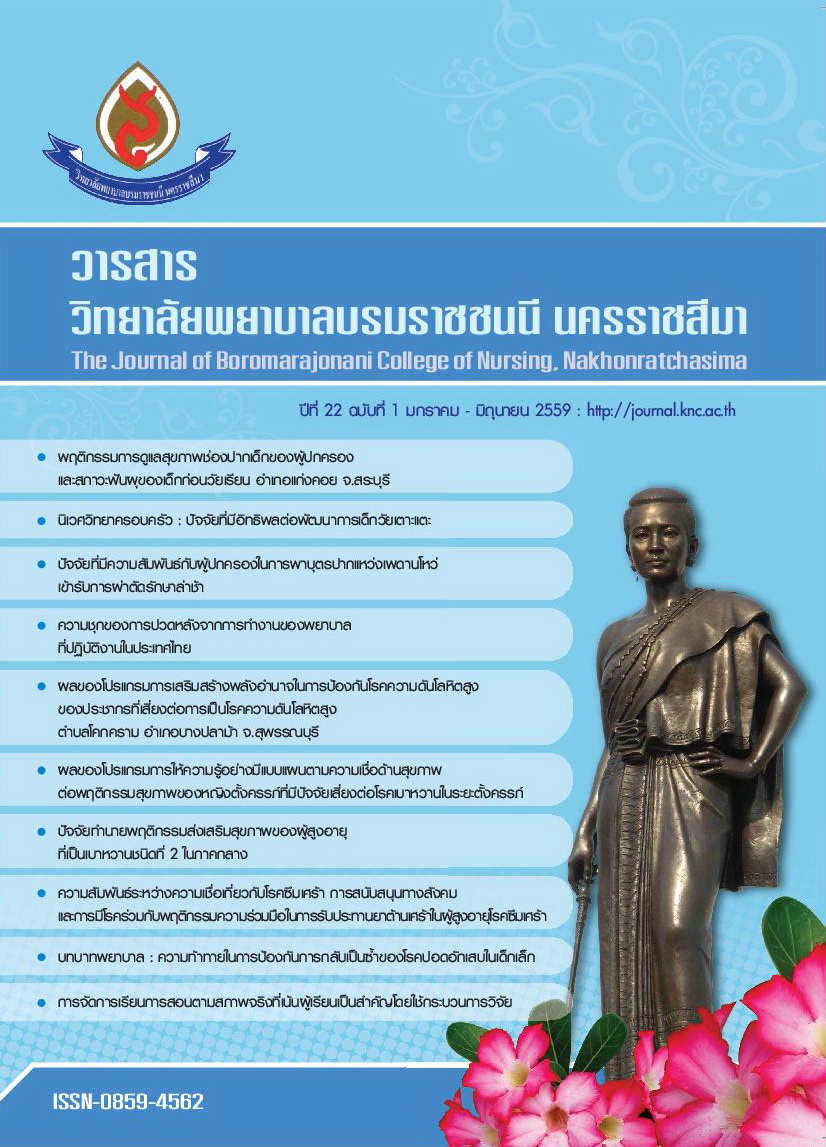ปัจจัยที่มีความสัมพันธ์กับผู้ปกครองในการพาบุตรปากแหว่งเพดานโหว่ เข้ารับการผ่าตัดรักษาล่าช้า
คำสำคัญ:
ปัจจัยของผู้ปกครอง, ปากแหว่งเพดานโหว่, การพาบุตรมารับการผ่าตัดรักษาล่าช้า, Parents factors, Cleft lip and Cleft palate, Delayed surgical treatmentบทคัดย่อ
วิจัยนี้เป็นการศึกษาเชิงวิเคราะห์แบบย้อนหลัง (Unmatched case-control study) เพื่อหาปัจจัยที่มีความสัมพันธ์กับผู้ปกครองในการพาบุตรปากแหว่งเพดานโหว่เข้ารับการผ่าตัดรักษาล่าช้า ณ ศูนย์ปากแหว่งเพดานโหว่ โรงพยาบาลมหาราชนครราชสีมา จังหวัดนครราชสีมา ช่วงเดือนตุลาคม 2557 ถึง พฤษภาคม 2558 กลุ่มตัวอย่าง 138 ราย จำแนกเป็นกลุ่มที่พาบุตรมาผ่าตัดรักษาล่าช้า และมาผ่าตัดรักษาตามเกณฑ์ กลุ่มละ 69 ราย เก็บข้อมูลโดยแบบสอบถาม วิเคราะห์ทางสถิติด้วยโปรแกรม STATA 10.0 หาความสัมพันธ์ของปัจจัยแบบตัวแปรเดี่ยว (Univariate analysis) ด้วยสถิติ Chi-square และหาความสัมพันธ์แบบตัวแปรเชิงซ้อน (Multivariate Analysis) ด้วยการวิเคราะห์ถดถอยพหุโลจิสติค (Multiple Logistic Regression Analysis)
ผลการศึกษาพบว่า ผู้ปกครองที่พาบุตรมาผ่าตัดรักษาล่าช้าจำนวน 69 ราย เป็นเพศหญิง (76.8%) มากกว่าเพศชาย (23.2%) (OR=0.84; 95%CI = 0.34-2.05) ส่วนมากอายุระหว่าง 21-30 ปี (40.6%, mean = 30.7 ปี) และ 46.4% มีอาชีพรับจ้างทั่วไป เมื่อวิเคราะห์หาความสัมพันธ์แบบตัวแปรเชิงซ้อนด้วยการวิเคราะห์ถดถอยพหุโลจิสติค พบว่าสถานภาพสมรส หม้าย/หย่า/แยก (ORadj = 5.01, 95%CI = 1.03-24.32) รายได้ต่อเดือน ≤15,000 บาท (ORadj = 7.42, 95%CI = 1.09-50.70) บุตรเจ็บป่วยก่อนเข้ารับการผ่าตัด (ORadj = 17.76, 95%CI = 2.54-123.96) และระยะเวลาในการเดินทางมารักษาเดินทาง>60 นาที (ORadj = 6.19, 95%CI = 2.69-14.28) ดังนั้น เจ้าหน้าที่ควรมุ่งให้สุขศึกษาแก่ผู้ดูแลหลัก ให้ความรู้เกี่ยวกับปากแหว่งและ/หรือเพดานโหว่ พัฒนาระบบติดตามนัดหมายให้มีประสิทธิภาพ รวมไปถึงหน่วยงาน ทางสาธารณสุข องค์กรปกครองส่วนท้องถิ่นและองค์กรอื่นๆ ทั้งภาครัฐและเอกชน ควรร่วมมือกัน ให้ความช่วยเหลือ สนับสนุนด้านงบประมาณหรือช่องทางการส่งต่อที่เอื้อให้ผู้ป่วยกลุ่มนี้เข้าถึงการรักษาตามแนวทางเวชปฏิบัติและได้รับการผ่าตัดรักษาตามเกณฑ์ที่เหมาะสมต่อไป
Abstract
This Unmatched case-control analytical study was aimed at investigating factors associated with parents bringing children with cleft lip and/or cleft palate for delayed surgical treatment at the Cleft Lip and Palate Center, MaharatNakhonratchasima Hospital, Nakhonratchasima Province between October 2014 to May 2015. 138 cases were chosen and divided into two groups of 69 cases each. The first group represented cases with delayed treatment and the latter group was a control (no delayed treatment). Data were collected by questionnaires. The STATA 10.0 software program was used for statistical evaluation. Techniques employed were Univariate analysis using Chi-square test and Multivariate analysis using Multiple logistic regression analysis
The results showed that the delayed surgical treatment group, 69 cases comprised of female (76.8%) and male (23.2%) (OR = 0.84; 95%CI = 0.34-2.05) parents, most of them aged between 21-30 years (40.6%, mean = 30.7 years), and 46.4% were employed. In Multivariate analysis, the significant associated factors were marital status of the parent (widowed/divorced/separated (ORadj = 5.01, 95%CI = 1.03-24.32), income per month ≤15,000 baht (ORadj = 7.42, 95%CI = 1.09-50.70), children had an illness (ORadj = 17.76, 95%CI = 2.54-123.96), duration time of travelling to hospital >60 minutes (ORadj = 6.19, 95%CI = 2.69-14.28)
As a result of this study, staff should focus attention on caregiver education about cleft lip and/or palate procedures and institute a follow up monitoring system to assure timely treatment. In addition, public agencies and private organizations should cooperate to support budgets for referral pathways that allow vulnerable groups to gain access to the appropriate surgeries and standard guidelines.
ดาวน์โหลด
ฉบับ
ประเภทบทความ
สัญญาอนุญาต
บทความที่ได้รับการตีพิมพ์เป็นลิขสิทธิ์ของ วารสารสุขภาพและการศึกษาพยาบาล ซึ่งดำเนินการโดยวิทยาลัยพยาบาลบรมราชชนนี นครราชสีมา
ข้อความที่ปรากฏในบทความในวารสารเล่มนี้เป็นความคิดเห็นส่วนตัวของผู้เขียนแต่ละท่านไม่เกี่ยวข้องกับกองบรรณาธิการวารสารสุขภาพและการศึกษาพยาบาล หรือวิทยาลัยพยาบาลบรมราชชนนี นครราชสีมา แต่อย่างใด ความรับผิดชอบองค์ประกอบทั้งหมดของบทความแต่ละเรื่องเป็นของผู้เขียนแต่ละท่าน หากมีความผิดพลาดใดๆ ผู้เขียนแต่ละท่านจะรับผิดชอบบทความของตนเองแต่ผู้เดียว







